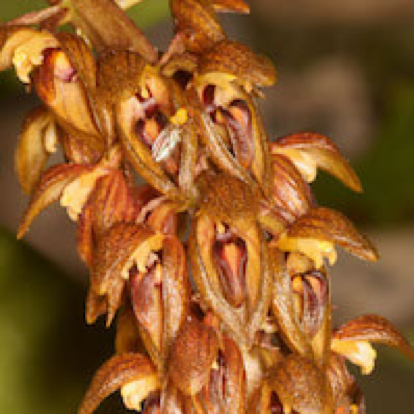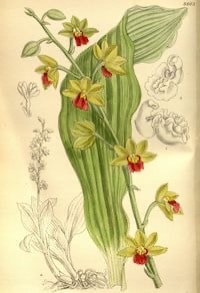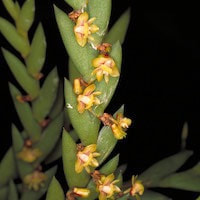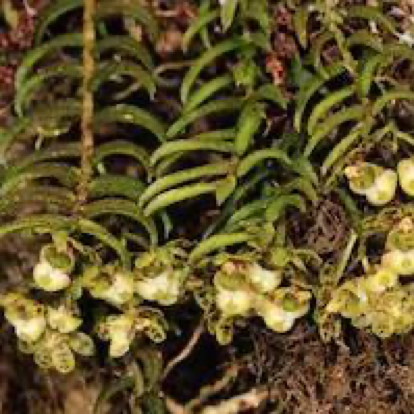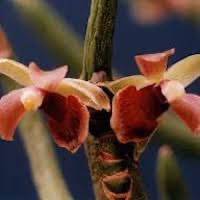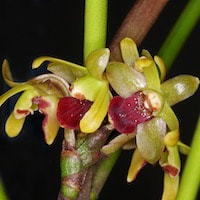WFL3- Women's Floral 3 - Flower Puff Girls
|
Native Singaporean Orchid notes: Bulbophyllum Vaginatum
Miltoniopsis Santanaei is a special orchid used in the Floral 3 (Women) perfume workshop for team building. Once very popular, these orchids were featured in many books and pictures because of their beautiful flowers. Known for their compact size and a lovely rose-like scent, miltoniopsis orchids are also used in making perfumes due to their pleasant fragrance, which is found in many hybrid varieties as well.
|
Therapeutic Orchid notes:
|
Bulbophyllum careyanum
It is an orchid species known for its conical pseudobulb that produces a musky smell. It has one elliptic leaf and blooms from the base of the pseudobulb. Native to places like Nepal, Bhutan, and Thailand, its scent can be musky, earthy, and slightly sweet, which some might find unpleasant but others find intriguing. Traditionally, people use its pseudobulbs and leaves in poultices to treat skin burns, giving it value in natural remedies. |
|
Bulbophyllum careyanum
Bulbophyllum careyanum, also called Sanlengxiaji Lan in Chinese, is an orchid valued for its medicinal uses. In traditional Chinese medicine, it is known as Jiuzilianhuancao, a name also used for Calanthe discolor. Found in regions like Shanxi and Sichuan, this orchid's leaves and pseudobulbs are used in Nepal for treating wounds and as aphrodisiacs, while in Uttarakhand, they treat jaundice and typhoid. Chinese medicine uses the root to improve circulation, relieve pain, and treat various ailments. Always consult a healthcare professional for proper use. |
|
Thai Name: Kang pla
Kang Pla, or Dendrobium kangplaense, is a small Dendrobium orchid from Thailand, Laos, Vietnam, Malaysia, and Indonesia. While it produces many flowers, it is not highly valued in horticulture due to their small size. In traditional Thai medicine, the whole plant is used as a herbal remedy for headaches. Although this use is based on tradition, there is limited scientific research on its effectiveness and safety. Always consult a healthcare professional before using herbal remedies for health issues. |
|
Gastrochilus distichus (Lindl.) Kuntze syn. Saccolabium distichum Lindl
Gastrochilus distichus, also known as Saccolabium distichum, is an orchid from southeast Tibet, Yunnan, Sikkim, Bhutan, and Nepal. In Chinese, it is called "Lieyepenju Lan," meaning "leaves in a row, pot distance orchid," and has the medicinal name "Fenghuangmao." This orchid contains alkaloids, though their details are not well-studied. In traditional medicine, it is used to treat mastitis, an inflammation of breast tissue. However, scientific evidence for its effectiveness and safety is limited, so consult a healthcare professional before use. |
|
Luisia morsei Rolfe
Dayangjiao, also known as Chaizigu, Jinhuancao, and Shucong, is an epiphytic orchid found in southern China and parts of Japan, Vietnam, Laos, and Thailand. In Traditional Chinese Medicine (TCM), it is used to promote the movement of “wind” in the body, boost yang energy, relieve vomiting, detoxify, and remove gas and dampness. It is also used in Taiwan for conditions like infantile paralysis, rheumatism, and malaria, and is believed to have insecticidal properties. Consult a healthcare professional before use due to limited scientific research. |
|
Luisia tristis (G.Forst.) Hook. f. Syn. Luisia teretifolia Gaudich., Luisia zeylandica Lindl.
Luisia tristis, also known as Luisia teretifolia and Luisia zeylandica, is an orchid found in regions like India, Bangladesh, Nepal, Sri Lanka, Thailand, and parts of Southeast Asia. It is called Koira in India and Bangladesh, Bori jhaar in Nepal, Muwa kiriya in Sri Lanka, and Kluai nam thai in Thailand. Known as Jinchaigu in Chinese medicine, it has various medicinal uses, including treating fractures, abscesses, and chronic wounds. It also helps with jaundice and diarrhea in cattle. Despite its traditional uses, scientific studies on its efficacy are limited, so consult a healthcare professional before use. |
Other scent note
Geranium, Forget-me-not, Encian, Gerbera, Lotus, Bell flower, Angel’s trumpet , Edelweiss, Magnolia, Snow flower
Scentopia Library Reference ingredient
Jasmin - Check details at Scentopia's scent library
Download the guided mediation that works best with this Orchid fragrance oil
| women_floral_essential_oil_orchi_00003.mp3 | |
| File Size: | 230478 kb |
| File Type: | mp3 |

